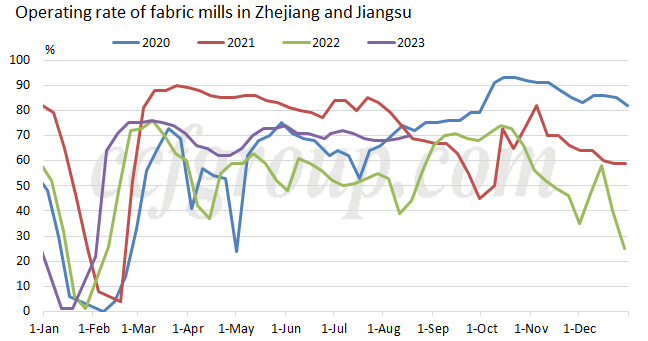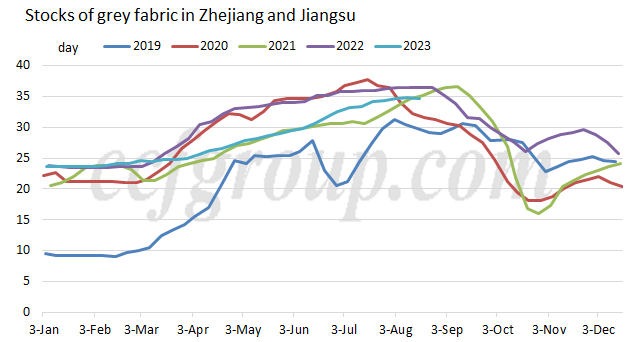Peak-season demand hard to make a big difference despite marginal improvement
Seasonal downstream demand improves slightly in recent period. The operating rate of fabric mills and printing and dyeing plants slightly ascends. Orders for autumn and winter products grow. Some dyeing plants also reflect slightly busier business. Price of grey fabrics is largely stable and that of tight varieties rises slightly. Stocks of grey fabrics are unlikely to accumulate in short run, and some plants may even see falling inventory.

Low profit is the biggest pain spot on downstream market and some plants even suffer losses. Orders are good in Haining but most plants are near the break-even line. Even when orders are growing, price and processing spread of grey fabrics are hard to increase as fabric mills worry the orders will run away. The price and profit on downstream market have been squeezed to be very low.
Downstream buyers are inactive in speculating feedstock. Sales of PFY only improve periodically. Downstream buyers only intensively purchased when price of polyester feedstock rose or PFY plants discounted price for promotion. The major reasons are mainly as follows: firstly, current PFY price has hit yearly high. Downstream buyers' buying interest will be hard to improve when downstream plants see low profit or even suffer losses. Secondly, current inventory of downstream market has been at yearly high. When the performance of peak season is expected to be modest, most downstream plants are active in controlling inventory. Thirdly, downstream value chain witnesses tight capital when the inventory is high at warehouse and some orders are concluded in debt. It is more difficult to recoup capital this year.
Seasonal demand has tended to improve recently, while the performance of traditional peak season in Sep and Oct may be hard to be good.
From the perspective of domestic demand, in Jan-May, 2023, there was a concentrated release of pent-up demand, such as travel, business, wedding ceremonies, visiting relatives, and house renovation, which drove the rapid recovery of domestic demand. However, in Jun and Jul, as pent-up demand gradually subsided, there were signs of slowing growth in domestic demand. The fundamental reason was that, when current economic environment is under pressure, the growth rate of residents' disposable income has limited potential for improvement, which hampers the growth of consumer spending. Even in situations where the household savings rate is relatively high, it is difficult to enhance the willingness to consume. Instead, it is more common for people to reduce leverage and pay off mortgages in advance.
The traditional peak season, which used to rely more on the domestic Double Eleven (November 11) promotion, has seen a decline in recent years. E-commerce platforms no longer release sales figures for Double Eleven, and with continuous promotions throughout the year, consumers' purchasing demand during Double Eleven has been spread out. According to preliminary surveys, some clothing companies and e-commerce platforms have proactively reduced their inventory this year. Firstly, they have lowered their expectations for the peak season, and secondly, the domestic sales are mainly small and quick orders in 2023, with occasional explosive hot-selling items. This situation will test the companies' ability to respond quickly rather than the quantity of stocked goods.
From the perspective of foreign trade, China's textile and apparel exports saw a year-on-year growth rate of -19% in Jan-Feb, which quickly rebounded to 19% in Mar. The unexpected surge in Mar was mainly due to the short-term factors of pent-up orders caused by the pandemic. However, it declined to 8.8% in Apr and further accelerated to below -10% from May to Jul. Although the export growth rate may narrow in Aug and afterward due to the low base of last year, the actual pressure remains significant. The global manufacturing Purchasing Managers' Index (PMI) has consistently remained below the expansion threshold, indicating a continued downturn in the global economy. The sustained weakness in manufacturing, particularly in Europe and the United States, may pose significant downward pressure on global manufacturing. In the context of inflation, households are reducing their expenditures on optional clothing and home textiles. Since the second half of 2022, imports of textile and apparel from Europe, America, and Japan have noticeably declined, with import volumes maintaining negative growth in 2023.
In terms of overseas inventory, the absolute clothing and fabric inventory for US wholesalers is declining but still has some distance to reach normal levels. The inventory-to-sales ratio keeps high and fluctuates. Overseas brand clothing is undergoing destocking, but the progress of destocking is lower than expected. According to Nike's latest financial report, inventory stood at US$8.5 billion as of the end of May, which was 30% higher than the end of 2021. Adidas' latest financial report showed that inventory reached 5.54 billion euros as of Jun, which was 38% higher than the end of 2021.
Back to polyester market, the run rate declined substantially in Jan-Feb, 2023, ending up with low inventory. Coupled with the release of domestic demand, rising export and the replenishment of industry, the polyester production grew and was practically consumed. In the second half of 2023, as earlier inventory is abundant, destocking is expected to more rely on domestic demand. If the performance in peak season is not good, the destocking cycle is likely to be extended, which will pose great pressure on the polyester polymerization rate in Q4.

In 2019, fabric inventory was relatively low, but since the impact of the pandemic in 2020, it has been at a higher level. In 2020, inventory was consumed through improved domestic and external demand in the fourth quarter. In 2021 and 2022, inventory was reduced through active and passive production cuts. Therefore, if the demand during the peak season is not strong in 2023, it may be necessary to further reduce production to destock later.
Current polyester polymerization rate was at 92.8%, which may reduce in Sep as some companies may be limited production due to the Asian Games. Some companies said they will limit production, including 200kt/year from Lianda and 750kt+600kt/year polymer of Hengyi Yijing. The specific time for production suspension has not been confirmed temporarily. In addition, some companies in Xiaoshan and Shaoxing of Zhejiang reflect that they will scale down output by 30%. Whether these enterprises will cut production or not and when will they start reducing production remain uncertain, needing further observation. Downstream printing and dyeing plants, DTY plants and fabric mills do not receive notice to limit production for the time being. The polyester polymerization rate in Q4 will depend on the performance in peak season, which may decrease further in Q4 if the performance of peak season is weaker than anticipated.
- Top keywords
- Cotton Price
- Cotton Futures Price
- Cotton Futures
- CZCE
- PTA Futures Price
- Chemical Fiber
- Polyester Prices
- Wool price
- PTA Futures
- Shengze Silk
- China
- Yarn Price
- price
- China Textile City
- Fibre Price
- Benzene Price
- Cotton
- Index
- Cotton Index
- PTA
- fabric price
- NYMEX
- Top 10
- textile industry
- Spot Cotton
- Cotton Yarn
- Polyester Price
- Futures
- PTA Price
- cotton yarn price

